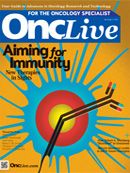Publication
Article
Oncology Live®
3 Questions for Srdan Verstovsek, MD, PhD
Author(s):
Srdan Verstovsek, MD, PhD, is a medical oncologist and associate professor in the Department of Leukemia at the University of Texas MD Anderson Cancer Center in Houston.

Srdan Verstovsek, MD, PhD
Srdan Verstovsek, MD, PhD, is a medical oncologist and associate professor in the Department of Leukemia at the University of Texas MD Anderson Cancer Center in Houston. He is the leader of the myeloproliferative disorders program, with research interests in understanding their biology, and developing and testing novel therapies. He has been involved in the clinical testing of Incyte’s ruxolitinib.
1.
What role does JAK signaling play in normal physiology?
JAKs are critical elements in the signaling of a number of cytokines (eg, interleukins and interferons) and growth factors (eg, erythropoietin and thrombopoietin) that are involved in normal bone marrow and immune cell functions. They stimulate JAK signaling upon binding to their respective cell surface receptors, ultimately leading to a number of cellular functions, including activation and proliferation. JAKs use transcription factors known as STATs to propagate the signals, and this pathway is therefore often referred to as the JAK-STAT pathway.
2.
How important is JAK signaling in cancer?
A number of lines of evidence implicated unchecked activation of the JAK-STAT pathway in the development of hematological malignancies, including myeloid and lymphoid leukemias. The earliest hint came from evidence that transformation of pre-B cells by v-abl resulted in persistent phosphorylation and activation of STAT.
Then, in 1997, a chromosomal translocation involving JAK2 and TEL, a gene encoding a member of the ETS transcription factor family, was associated with several types of leukemia. Most recently, an activating mutation in JAK2, known as JAK2 V617F, that results in a single amino acid substitution was discovered in Philadelphia chromosome-negative myeloproliferative neoplasms.
Although not widely prevalent in other types of blood cancers, this led to immense interest in this pathway. We are also beginning to appreciate the role of JAK-STAT signaling in solid tumors including breast cancer, pancreatic cancer, and non-small cell lung cancer.
3.
What is the future of JAK signaling in cancer research?
With the availability of selective, potent, and orally available JAK inhibitors with excellent tolerability profi le, I expect that there will be a great deal of interest in testing these agents in various cancers that are associated with dysregulated JAK-STAT signaling.
In addition, JAK inhibitors could be combined with other agents based on the mechanistic rationale that STAT signaling is potentially involved in resistance to chemotherapeutic agents and other tyrosine kinase inhibitors.










